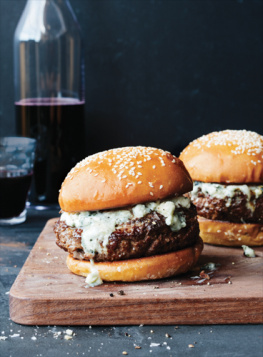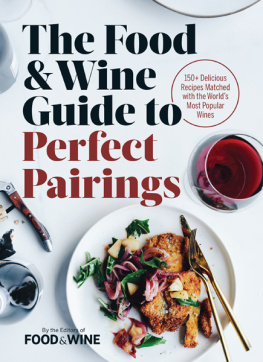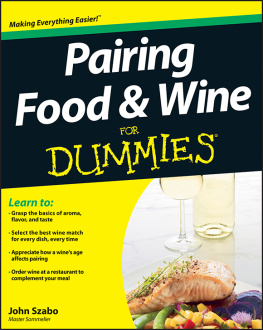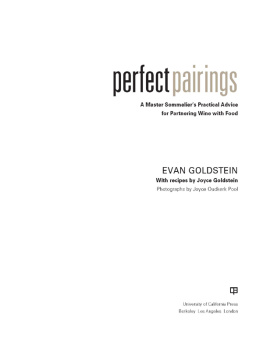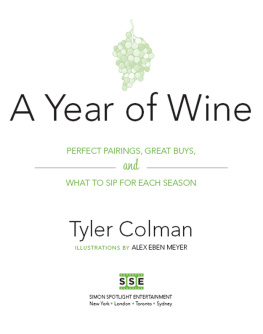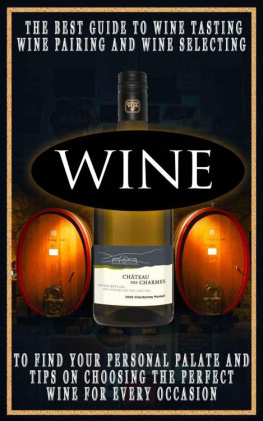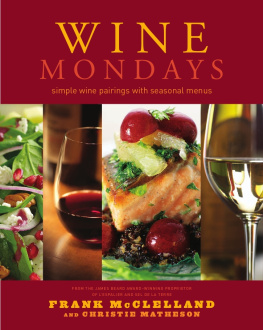
FOOD & WINE
SPECIEL COLLECTORS EDITION
PERFECT PAIRINGS
WINES AND FOODS THAT GO TOGETHER
Foreword
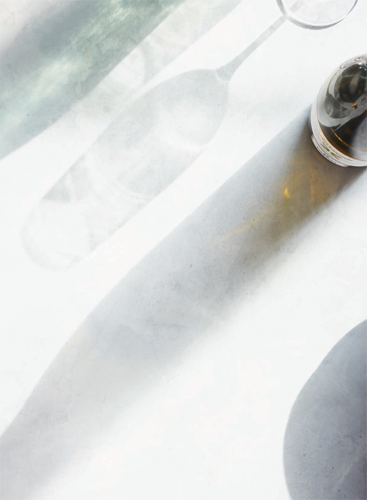
Heres a question: Is pairing wine with food a devilishly complex exercise, full of pitfalls for the unwary, or is it as simple as pouring wine you like alongside the food you like to eat?
The answer: Its a little bit of both. A great pairing can lift both the wine and accompanying dish into another plane, heightening flavors and aromas. When done right, it results in a kind of alchemya 1+1=3 intensity that will be both incredibly pleasurable and also truly memorable. At the same time, wineany winewillgo better with your food than practically anything else you can drink. Its a beverage truly made to be on the table.
Should you worry or fret about which wine goes with which food? Of course not; Life is too short! But should you experiment, have fun with the concept and find your favorite combos? Absolutely. And thats where this book comes in. Weve chosen 10 of the most popular grape varieties and categories of wine, and selected their best food matchesthe dishes that will truly make them sing. Have a bottle of terrific Sonoma Chardonnay on hand that youve been waiting to drink? . We guarantee theyll be wowed.
There are 118 remarkable recipes in these pages, from both F&Ws Test Kitchen cooks as well as many of the worlds leading chefs. And weve added in-depth information about each wine variety, as well as similar choices that work equally well for pairing. The result is an invaluable resource for anyone who loves both wine and food. Cheers!

Ray Isle
Executive Wine Editor
FOOD & WINE
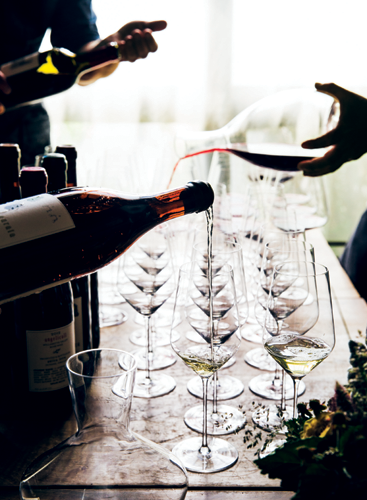
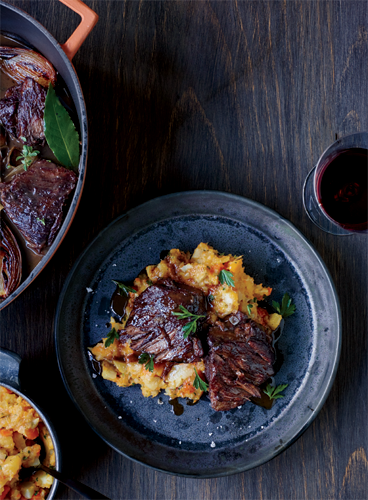
SPARKLING
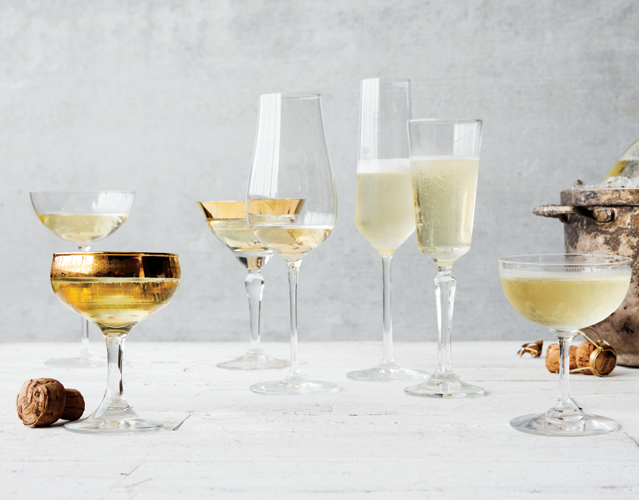
CHAMPAGNE
& OTHER SPARKLING WINES
CHAMPAGNE The grande dame of all sparkling wines, Champagne comes from the region of Champagne, in northern France, respected worldwide for wines of outstanding complexity and ageability. That said, the traditional method employed to make sparkling wine in Champagne has been used around the world for centuries. This method hinges on a two-step fermentation process: The first is carried out in a tank or barrel (as with most still wines), and the second step, by which the bubbles are instilled into the wine, takes place in the bottle.
Champagnes are made using varying percentages of three grape varieties: Chardonnay, Pinot Noir and Pinot Meunier. Percentages depend on the desired style, from light and delicate all the way to rich and vinous. There is no question that Champagne represents luxury and indulgence, but its also fantastic with crispy fried chicken or a bowl of salty potato chips. (The bubbles interact with salt in an almost magical way.) While Champagne is certainly excellent with appetizers, it can be equally delicious throughout the entire meal. Sommeliers, in fact, love to say that Champagne goes well with everything. Whether thats true, theres no denying that its tremendous with shellfish, scrambled eggs, creamy soups and pastas, fish and lighter meats.
PROSECCO Italy makes a handful of different sparkling wines (Franciacorta, Lambrusco, Moscato dAsti), but its signature fizz is undeniably Prosecco, the lightly floral, fruit-forward sparkler from the regions just north of Venice. Prosecco can be made from a handful of different varieties, but the most important is a white grape called Glera. Prosecco winemakers utilize a much quicker (months versus years) process than Champagne producers for getting bubbles in their wine, called the Charmat method. In it, grapes are fermented as usual, then the juice is sealed in enormous pressurized stainless steel vats for the second fermentation. The result: frothy, approachable wines that are both affordable and light-hearted. A brunch go-to, Prosecco is otherwise best with lighter foods and starters.
CAVA While Cava can legally come from anywhere in Spain, the greatest examples are made in a part of Catalonia called Peneds. Here, producers make dry sparkling wines with varying amounts of three native Spanish grape varieties: Macabeo, Xarel-lo and Parellada. Classic Cava has a distinct green apple perkiness and earthy depth thats matched by soft bubbles. It goes well with cheese and charcuterie, as well as seafood, salads and crispy fried snacks.
Grilled Escarole Toasts with Trout Roe
TIME 45 min total
MAKES 6 servings
Winemaker Maggie Harrison transforms simple escarole into dinner partyworthy toasts: She tops each one with crme frache and trout roe, which is smaller, milder and less salty than salmon roe.
Two 10- to 12-oz. heads of escarole
cup extra-virgin olive oil, plus more for brushing
1 Tbsp. chopped thyme
2 garlic cloves, minced
Kosher salt and pepper
Eighteen -inch-thick baguette slices, cut on a wide diagonal
Crme frache and trout roe, for serving
STEP 1 Light a grill. Fill a large bowl with cold water. Holding the escarole by the root end, dip the heads in the water to release any dirt between the leaves. Shake off the excess water.
STEP 2 In a small bowl, whisk the cup of olive oil with the thyme and garlic. Brush escarole with garlic oil and season with salt and pepper. Grill over moderate heat until charred outside and tender within, about 20 minutes; brush a few times with garlic oil during grilling. Transfer to a work surface and let cool, then coarsely chop.
STEP 3 Brush the baguette slices with olive oil and season with salt and pepper. Grill until lightly charred on both sides, about 2 minutes.
STEP 4 In a large bowl, toss escarole with remaining garlic oil; season with salt and pepper. Top the toasts with the escarole, crme frache and roe and serve. Maggie Harrison
WINE TIP
Crisp Champagne is an outstanding match for the briny trout roe, rich crme frache and garlicky grilled bitter greens here.
Tuna Briks
TIME 30 min total
MAKES 8 small pies
Briks are small, triangular savory pastries made throughout Tunisia with fillings that range from meat and egg to mashed potato. A universal ingredient, though, is harissa, a fiery North African chile paste. This version is wrapped in store-bought phyllo dough and filled with scallions, capers and canned tuna.
Two 7-oz. cans tuna packed in water, drained well and flaked
cup finely chopped scallions
cup chopped drained capers
cup chopped parsley
cup extra-virgin olive oil
2 Tbsp. harissa
Kosher salt and pepper
6 sheets of phyllo dough
1 large egg, beaten
Canola oil, for frying
STEP 1 In a medium bowl, combine tuna, scallions, capers, parsley, olive oil and harissa. Season with salt and pepper and mix gently.
STEP 2 On a work surface, make 2 stacks of 3 phyllo sheets each. Cut each stack crosswise into four 4-by-12-inch strips. Work with 1 strip at a time, keeping the rest covered with a damp kitchen towel. Place a heaping cup of the tuna filling at the end of a strip closest to you. Brush the edge of the other end with the beaten egg. Fold the corner of the phyllo over filling to form a triangle. Continue folding the triangle up and over itself until you reach the end of the strip; press to adhere. Repeat with the remaining phyllo strips, filling and beaten egg.
Next page
